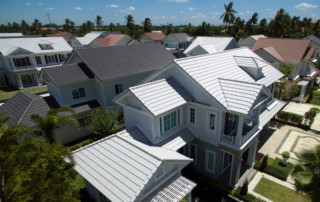Roof slope is an essential consideration when determining the proper roofing system and roofing materials for a home. Primarily, the slope determines how effective the roof will be at shedding water and debris from ridges and seams. The more easily that water can roll off a roof, the less likely it can collect and result in leaks. The wrong roof slope can also void material warranties and affect your ability to get a permit.
While most homeowners are not involved in determining the roof slope and design of their roof, knowing how the structure works is valuable in order to make smart maintenance and new roof installation decisions.
The Differences Between Low & High Slope Roofs
Roof slope is most often referred to as “pitch”.
A low-pitched (low slope) roof presents a rise of no more than 3 inches per horizontal foot. Low slope roofs are most often seen on commercial buildings, although some styles of architecture do highlight flat roofing. The low pitched roof is comprised of three main components – a weatherproof layer, reinforcement layers, and a surface material.
The weatherproof layer, typically made from some form of thermoset, thermoplastic or modified bitumen, is designed to withstand any weather condition and effectively repel water and storm debris. Reinforcement layers are made of fabric which augment the waterproof layer by adding strength, alignment, longevity and resistance to sharp objects. The surface materials provide the two layer underneath with an aesthetic finish which provide the final look of the roof, as well as further reinforcing the protective barriers.
Steeper slope roofs utilize materials and specific design to prevent debris and water from collecting or pooling on the structure. A high slope roof is any roof which rises more than 3 inches per horizontal foot. In contrast to flat roofs, these roofs are more visible. Therefore, roof coverings to ensure weatherproofing and a more pleasing appearance are generally required, especially as these roofs are most often seen in residential settings.
The three main elements of high slope roofs include a roof deck, an underlayment, and roof covering materials. The roof deck includes the entire support system which holds up the weight and structure of the roof. (frame, eaves, beams). The underlayment is affixed to the roof deck and functions as a barrier between the roof’s outer surface and the base structure. The underlayment is a protective shield against the elements, and acts preventatively against future leaks. The outer layer of roofing material is typically chosen based upon cost and aesthetic value, as it is the most visible part of the roof. Popular roofing materials in the Venice and Sarasota areas include asphalt shingle, ceramic tile, metal, concrete, and stone or slate.
Important Construction Note: If you decide to change your roof slope – for instance, if you wish to add a slope to a flat roof design – a building permit will be required in order to stay compliant with local codes and regulations. As stated, the homeowners will rarely deal with procuring necessary permits if they hire a professional roofing contractor, who will file for all permits on the homeowner’s behalf before the work is completed.
If you are interested in options regarding your roof slope, whether for aesthetic or functional purposes, call [company_name] first. We will perform an inspection, advise you of your options and the related costs, and help you to achieve the roof you need.




